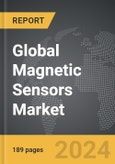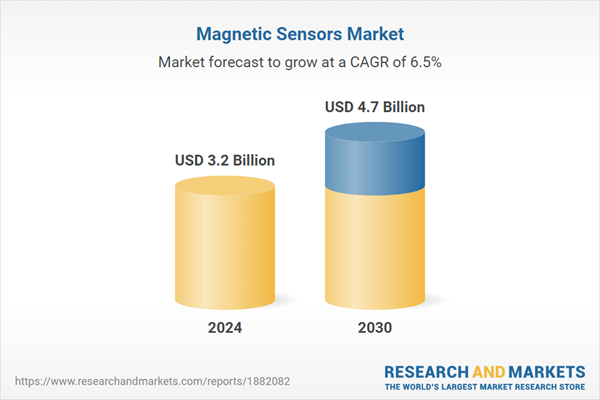The global market for Magnetic Sensors was valued at US$3.2 Billion in 2024 and is projected to reach US$4.7 Billion by 2030, growing at a CAGR of 6.5% from 2024 to 2030. This comprehensive report provides an in-depth analysis of market trends, drivers, and forecasts, helping you make informed business decisions. The report includes the most recent global tariff developments and how they impact the Magnetic Sensors market.
The measurement process in magnetic sensors involves detecting the strength and direction of magnetic fields, typically induced by electric currents, making them essential in systems that require precise magnetic responses. Companies like Honeywell lead in creating these devices that are indispensable in navigation systems and serve crucial roles in various scientific and industrial applications. The development and enhancement of magnetic sensors are greatly aided by advancements in modeling and simulation techniques, which help assess how changes in design or materials affect sensor performance. This process is particularly centered around Magnetic Tunnel Junctions (MTJs), utilizing the Tunneling Magnetoresistance Effect (TMR), with the National Institute of Standards & Technology (NIST) playing a pivotal role in diagnosing TMR properties early in the sensor development process. This collaboration with small companies, universities, and national labs helps in optimizing MTJ sensors, enhancing their efficiency and time-to-market.
Growth in the magnetic sensor market is driven by several critical factors. Technological integration in increasingly smart, interconnected devices necessitates the inclusion of magnetic sensors in mobile devices, automotive systems, and IoT devices for precise measurement and detection. There is also rising consumer demand for enhanced functionality in applications such as navigation, fitness tracking, and augmented reality in smartphones and wearable technologies. Regulatory and safety requirements in the automotive industry demand critical functions such as vehicle stability and anti-lock braking systems to integrate advanced magnetic sensors. Further, developments in material science have led to new materials with improved magnetic properties, enhancing sensor efficiency and broadening potential applications. The expansion in automotive applications, including electric and autonomous vehicles, and increased automation in industrial processes underline the growing necessity for reliable sensor technology. Additionally, the burgeoning consumer electronics market, particularly in developing regions, and innovations in healthcare employing magnetic sensors for diagnostics and patient monitoring underscore the diverse and expanding applications of magnetic sensor technology.
Segments: Technology (Hall Effect, Anisotropic Magnetoresistance (AMR), Giant Magnetoresistance (GMR), Tunnel Magnetoresistance (TMR), Other Technologies); Application (Automotive, Consumer Electronics, Industrial, Other Applications).
Geographic Regions/Countries: World; United States; Canada; Japan; China; Europe (France; Germany; Italy; United Kingdom; Spain; Russia; and Rest of Europe); Asia-Pacific (Australia; India; South Korea; and Rest of Asia-Pacific); Latin America (Argentina; Brazil; Mexico; and Rest of Latin America); Middle East (Iran; Israel; Saudi Arabia; United Arab Emirates; and Rest of Middle East); and Africa.
The analysts continuously track trade developments worldwide, drawing insights from leading global economists and over 200 industry and policy institutions, including think tanks, trade organizations, and national economic advisory bodies. This intelligence is integrated into forecasting models to provide timely, data-driven analysis of emerging risks and opportunities.
Global Magnetic Sensors Market - Key Trends and Drivers Summarized
Magnetic sensors are fundamental in myriad applications across industries such as industrial manufacturing and consumer electronics due to their precision in measuring the proximity, position, and displacement of objects. These devices, which detect variations within a magnetic field, such as flux, strength, and direction, come in two primary types: those measuring the total magnetic field and those that assess vector components of the field. The latter provides precise point measurements, crucial for applications like valve positioning, level detection, safety enhancements, and process monitoring. Innovations in sensor technology, especially improvements in sensitivity, have broadened the scope of magnetic sensors, now also pivotal in weapon detection, medical devices, and data storage solutions. They rely on a magnetoresistive element within a chip to detect magnetic vectors, which then changes resistance values, indicating the field’s presence and orientation, a feature critical in navigation systems where accuracy and reliability are paramount.The measurement process in magnetic sensors involves detecting the strength and direction of magnetic fields, typically induced by electric currents, making them essential in systems that require precise magnetic responses. Companies like Honeywell lead in creating these devices that are indispensable in navigation systems and serve crucial roles in various scientific and industrial applications. The development and enhancement of magnetic sensors are greatly aided by advancements in modeling and simulation techniques, which help assess how changes in design or materials affect sensor performance. This process is particularly centered around Magnetic Tunnel Junctions (MTJs), utilizing the Tunneling Magnetoresistance Effect (TMR), with the National Institute of Standards & Technology (NIST) playing a pivotal role in diagnosing TMR properties early in the sensor development process. This collaboration with small companies, universities, and national labs helps in optimizing MTJ sensors, enhancing their efficiency and time-to-market.
Growth in the magnetic sensor market is driven by several critical factors. Technological integration in increasingly smart, interconnected devices necessitates the inclusion of magnetic sensors in mobile devices, automotive systems, and IoT devices for precise measurement and detection. There is also rising consumer demand for enhanced functionality in applications such as navigation, fitness tracking, and augmented reality in smartphones and wearable technologies. Regulatory and safety requirements in the automotive industry demand critical functions such as vehicle stability and anti-lock braking systems to integrate advanced magnetic sensors. Further, developments in material science have led to new materials with improved magnetic properties, enhancing sensor efficiency and broadening potential applications. The expansion in automotive applications, including electric and autonomous vehicles, and increased automation in industrial processes underline the growing necessity for reliable sensor technology. Additionally, the burgeoning consumer electronics market, particularly in developing regions, and innovations in healthcare employing magnetic sensors for diagnostics and patient monitoring underscore the diverse and expanding applications of magnetic sensor technology.
Report Scope
The report analyzes the Magnetic Sensors market, presented in terms of units. The analysis covers the key segments and geographic regions outlined below.Segments: Technology (Hall Effect, Anisotropic Magnetoresistance (AMR), Giant Magnetoresistance (GMR), Tunnel Magnetoresistance (TMR), Other Technologies); Application (Automotive, Consumer Electronics, Industrial, Other Applications).
Geographic Regions/Countries: World; United States; Canada; Japan; China; Europe (France; Germany; Italy; United Kingdom; Spain; Russia; and Rest of Europe); Asia-Pacific (Australia; India; South Korea; and Rest of Asia-Pacific); Latin America (Argentina; Brazil; Mexico; and Rest of Latin America); Middle East (Iran; Israel; Saudi Arabia; United Arab Emirates; and Rest of Middle East); and Africa.
Key Insights:
- Market Growth: Understand the significant growth trajectory of the Hall Effect segment, which is expected to reach US$2.0 Billion by 2030 with a CAGR of a 6.3%. The Anisotropic Magnetoresistance (AMR) segment is also set to grow at 5.6% CAGR over the analysis period.
- Regional Analysis: Gain insights into the U.S. market, valued at $845.2 Million in 2024, and China, forecasted to grow at an impressive 9.7% CAGR to reach $1.1 Billion by 2030. Discover growth trends in other key regions, including Japan, Canada, Germany, and the Asia-Pacific.
Why You Should Buy This Report:
- Detailed Market Analysis: Access a thorough analysis of the Global Magnetic Sensors Market, covering all major geographic regions and market segments.
- Competitive Insights: Get an overview of the competitive landscape, including the market presence of major players across different geographies.
- Future Trends and Drivers: Understand the key trends and drivers shaping the future of the Global Magnetic Sensors Market.
- Actionable Insights: Benefit from actionable insights that can help you identify new revenue opportunities and make strategic business decisions.
Key Questions Answered:
- How is the Global Magnetic Sensors Market expected to evolve by 2030?
- What are the main drivers and restraints affecting the market?
- Which market segments will grow the most over the forecast period?
- How will market shares for different regions and segments change by 2030?
- Who are the leading players in the market, and what are their prospects?
Report Features:
- Comprehensive Market Data: Independent analysis of annual sales and market forecasts in US$ Million from 2024 to 2030.
- In-Depth Regional Analysis: Detailed insights into key markets, including the U.S., China, Japan, Canada, Europe, Asia-Pacific, Latin America, Middle East, and Africa.
- Company Profiles: Coverage of players such as Advanced Hall Sensors Ltd., Aeco s.r.l., AI-Tek Instruments LLC, Allegro MicroSystems, Inc., Alps Alpine Co., Ltd. and more.
- Complimentary Updates: Receive free report updates for one year to keep you informed of the latest market developments.
Some of the 34 companies featured in this Magnetic Sensors market report include:
- Advanced Hall Sensors Ltd.
- Aeco s.r.l.
- AI-Tek Instruments LLC
- Allegro MicroSystems, Inc.
- Alps Alpine Co., Ltd.
- ANGSemi Microelctronics
- ANTCLABS Inc.
- Applied Physics Systems, Inc.
- Aquascan International Ltd.
- Asahi Kasei Microdevices Corporation
Tariff Impact Analysis: Key Insights for 2025
Global tariff negotiations across 180+ countries are reshaping supply chains, costs, and competitiveness. This report reflects the latest developments as of April 2025 and incorporates forward-looking insights into the market outlook.The analysts continuously track trade developments worldwide, drawing insights from leading global economists and over 200 industry and policy institutions, including think tanks, trade organizations, and national economic advisory bodies. This intelligence is integrated into forecasting models to provide timely, data-driven analysis of emerging risks and opportunities.
What’s Included in This Edition:
- Tariff-adjusted market forecasts by region and segment
- Analysis of cost and supply chain implications by sourcing and trade exposure
- Strategic insights into geographic shifts
Buyers receive a free July 2025 update with:
- Finalized tariff impacts and new trade agreement effects
- Updated projections reflecting global sourcing and cost shifts
- Expanded country-specific coverage across the industry
Table of Contents
I. METHODOLOGYII. EXECUTIVE SUMMARY2. FOCUS ON SELECT PLAYERSIII. MARKET ANALYSISCANADAITALYSPAINRUSSIAREST OF EUROPESOUTH KOREAREST OF ASIA-PACIFICARGENTINABRAZILMEXICOREST OF LATIN AMERICAIRANISRAELSAUDI ARABIAUNITED ARAB EMIRATESREST OF MIDDLE EASTIV. COMPETITION
1. MARKET OVERVIEW
3. MARKET TRENDS & DRIVERS
4. GLOBAL MARKET PERSPECTIVE
UNITED STATES
JAPAN
CHINA
EUROPE
FRANCE
GERMANY
UNITED KINGDOM
ASIA-PACIFIC
AUSTRALIA
INDIA
LATIN AMERICA
MIDDLE EAST
AFRICA
Companies Mentioned (Partial List)
A selection of companies mentioned in this report includes, but is not limited to:
- Advanced Hall Sensors Ltd.
- Aeco s.r.l.
- AI-Tek Instruments LLC
- Allegro MicroSystems, Inc.
- Alps Alpine Co., Ltd.
- ANGSemi Microelctronics
- ANTCLABS Inc.
- Applied Physics Systems, Inc.
- Aquascan International Ltd.
- Asahi Kasei Microdevices Corporation
Table Information
| Report Attribute | Details |
|---|---|
| No. of Pages | 189 |
| Published | April 2025 |
| Forecast Period | 2024 - 2030 |
| Estimated Market Value ( USD | $ 3.2 Billion |
| Forecasted Market Value ( USD | $ 4.7 Billion |
| Compound Annual Growth Rate | 6.5% |
| Regions Covered | Global |









